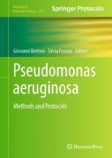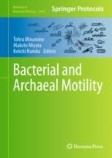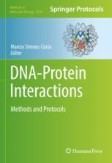Search
Search Results
-
ORE-Seq: Genome-Wide Absolute Occupancy Measurement by Restriction Enzyme Accessibilities
Digestion with restriction enzymes is a classical approach for probing DNA accessibility in chromatin. It allows to monitor both the cut and the...
-
Cell Cycle–Specific Protein Phosphatase 1 (PP1) Substrates Identification Using Genetically Modified Cell Lines
The identification of protein phosphatase 1 (PP1) holoenzyme substrates has proven to be a challenging task. PP1 can form different holoenzyme...
-
Tethered mRNA Amplifier: A Novel Approach to Increase Protein Expression
Posttranscriptional RNA modification has become a revolutionary clinical tool to improve the underlying condition in genetic disorders. The cell...
-
Biosensors for Inducers of Transient Antibiotic Resistance
The acquisition of an antibiotic resistance phenotype can be due to genetic modifications (heritable) or transient changes in bacterial physiology...
-
Cloning Strategy for HDAC1/HDAC2 Hybrid Protein Expression in Mammalian Cells
Dynamic deacetylation of non-histone proteins by histone deacetylases (HDACs) is a key regulator of protein functions, interactions, and turnover....
-
Pseudomonas aeruginosa Soluble Pyocins as Antibacterial Weapons
Pseudomonas aeruginosa is an opportunistic pathogen causing nosocomial infections and associated with lung infections in cystic fibrosis (CF)...
-
Stabilization of Enzymes by Using Thermophiles
Manufactured steroid compounds have many applications in the pharmaceutical industry. Due to the chemical complexity and chirality of steroids, there...
-
Genetic Manipulation of Haloferax Species
In this chapter, we describe the reverse genetics methodology behind generating a targeted gene deletion or replacement in archaeal species of the...
-
A Lambda-Exonuclease SELEX Method for Generating Aptamers to Bacterial Targets
Nucleic acid aptamers are short sequences of single-stranded (ss) DNA or RNA that fold into a three-dimensional shape with useful binding properties....
-
Large Complexes: Cloning Strategy, Production, and Purification
With few exceptions—such as myxobacteria, filamentous cyanobacteria, and actinomycetes (Rokas, Annu Rev Genet 42:235–251, 2008)—bacteria are defined...
-
A New Method for Gene Deletion to Investigate Cell Wall Biogenesis in Fusobacterium nucleatum
Controlled septal peptidoglycan hydrolysis is vital for bacterial cell division, preserving cellular integrity and facilitating proper daughter cell...
-
Social Motility Assays of Flavobacterium johnsoniae
Flavobacterium johnsoniae cells move rapidly over solid surfaces by gliding motility. The collective migration of F. johnsoniae on the surfaces...
-
Rapid Single-Pot Assembly of Modular Chromatin Proteins for Epigenetic Engineering
Chromatin is the nucleoprotein complex that organizes genomic DNA in the nuclei of eukaryotic cells. Chromatin-modifying enzymes and...
-
Efficient Generation of Stable Cell Lines with Inducible Neuronal Transgene Expression Using the piggyBac Transposon System
The piggyBac transposon system has been adapted to be a highly efficient genome engineering tool for transgenesis of eukaryotic cells and organisms....
-
GST Pull-Down Assay to Study PIF4 Binding In Vitro
The phytochrome-interacting factor 4 (PIF4) is a well-known transcription factor that plays a pivotal role in plant thermomorphogenesis, coordinating...
-
Classical Recombinant DNA Cloning
Traditional molecular cloning involves a series of linked experimental steps performed with the overall goal of isolating (“cloning”) a specific DNA...
-
Isolation of Genes Encoding Carbon Metabolism Pathways from Complex Microbial Communities
The ability to produce high-value products using bacteria will increasingly rely on continued research to make large-scale bacterial...
-
Investigating Fungal Biosynthetic Pathways Using Pichia pastoris as a Heterologous Host
Fungal natural products have extensive biological activities, and thus have been largely commercialized in the pharmaceutical, agricultural, and food...
-
Investigating Fungal Biosynthetic Pathways Using Heterologous Gene Expression: Aspergillus nidulans as a Heterologous Host
Fungal natural products encompass an important source of pharmaceutically relevant molecules. Heterologous expression of biosynthetic pathways in...
-
Cloning and Recombinant Protein Expression in Lactococcus lactis
The Lactococcus lactis, a Gram-positive bacteria, is an ideal expression host for the overproduction of heterologous proteins in a properly folded...
